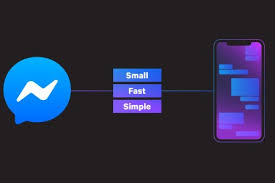Last week, Facebook began rolling out a new, streamlined version of Facebook Messenger on iOS, which most notably sees the removal of the ‘Discover’ tab, narrowing you in-app navigation options.
The update is in line with Facebook’s long-standing vision to simplify its core messaging surface after years of updates and changes “cluttered” the app. And this week, Facebook Messenger has provided a more comprehensive overview of exactly how the new upgrade improves the app’s performance, while also outlining why Facebook has chosen to undertake such a significant revamp of the Facebook messenger app.
The key element here is speed – as outlined by Facebook:
“People turn to message apps throughout the day to stay in touch with the people they care about so it’s important the app loads quickly and is simple to use. On the heels of Facebook Messenger 4, we started a journey to simplify and redesign Facebook Messenger, internally called Project LightSpeed, and now we’ve rebuilt the iOS app from the ground up.”
Facebook Messenger 4 is the version of Messenger launched in 2018, which reduced the number of tabs in the app, and sought to put more focus on the core messaging functionality, as opposed to periphery elements like games, bots, etc. This new version takes that a step further again, which, according to Facebook, has enabled it to significantly improve app performance.
“Compared with the previous iOS version, Facebook Messenger is twice as fast to start and one-fourth the size. With this new iteration, we’ve reimagined how Facebook Messenger thinks about building apps and started from the ground up with a new client core and a new server framework.”
Facebook also says that they’ve reduced Messenger’s core code by 84%, going from 1.7+ million lines of code to 360,000, making it easier to understand, easier to upgrade, and better to run.
Of course, there’s some question as to how much the average user really cares about the space an app takes up on their device, or the speed in which it loads, within reasonable bounds. In general, Facebook Messenger has not been widely criticized for slow load times – but then again, a more streamlined, improved messaging process would likely go unnoticed, yet still make it a more appealing option.
But there is another motivation for Facebook’s Messenger upgrade, one which is important to also note:
“LightSpeed not only makes the app faster, smaller, and simpler for our users, it also lays the foundation to fulfill our vision for private messaging and interoperability across apps, allowing us to scale our messaging experience in the future.”
That’s right, Facebook is still working towards its unified messaging back-end, which may be about fusing all of its tools together to avoid a potential break-up of its company by regulators, or maybe about simply making it easier for users to send messages across the various app surfaces.
Bottom of Form
Either way, you look at it, the Facebook Messenger update makes a lot more sense in this context. Sure, bots and games haven’t taken off in Messenger as Facebook had hoped, but removing them as key elements is as much about simplifying the connectors as it is about addressing usability concerns.
Now, Facebook’s various messaging services are moving more into line, which will enable them to be plugged into one another, so that you can send a message from Instagram to WhatsApp to Messenger, etc. That has functional benefits, for sure, but the structural benefit may be more significant.
